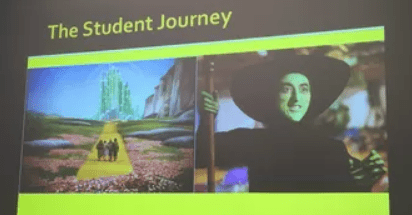Lee-Ann Sequeira considers an alternative view – that trigger warnings may not be the solution to issues surrounding mental wellbeing in the classroom.
Trigger warnings, like a number of interventions in higher education, stem from good intentions – to help students, to signpost emotive topics, to warn learners who may be experiencing post-traumatic stress disorder (PTSD) – for instance, issuing a warning that a text or presentation contains references to genocide. However, while good intentions are a necessary condition for good teaching practice, they are not sufficient. Proponents believe the use of trigger warnings encourage inclusivity and empathy towards vulnerable students and those from marginalised groups. It is indeed difficult to argue against inclusivity and empathy, but rather than achieving these results, the use of trigger warnings can be counterproductive.
The science
Trigger warnings have their roots in PTSD therapy and support groups, where trauma survivors learnt to become aware of what triggered their physical reaction to stressful incidents. The Noughties saw trigger warnings and alerts appear on online fora discussing topics such as self-harm, sexual abuse, etc. in response to user requests. The idea was that readers who were coming to terms with their trauma could avoid those threads or posts. However, exposure therapy and cognitive behaviour therapy which are typically used to treat PTSD hold that avoidance of triggers is detrimental to recovery. Some advocates of trigger warnings believe they should not be used to avoid parts of the curriculum, but to “help students to stop for a moment and breathe, which helps them to think.” But even this runs counter to established medical practice as announcing or reading a trigger warning in class is not a suitable setting for dealing with a highly disturbing flashback. It is this basic scientific logic that often gets lost in the rhetoric around trigger warnings. A trigger warning does not mean a PTSD survivor will necessarily be able to avoid an attack, nor can all possible triggers in a group of students be identified and announced in advance. Therefore, trigger warnings remain an ineffective and inconsistent form of dealing with PTSD.
Implications for policy
As has occurred online, in universities too, the push for the introduction of trigger warnings has come from user groups i.e. students. And university administrations have taken heed. At the University of Glasgow, theology students were issued a trigger warning about the crucifixion of Christ. As a spokesperson from the University’s Theology and Religious Society put it, “When dealing with visual depictions of the crucifixion in particular, there is a lot of gore involved. Many, many people have an issue with the sight of blood. Pre-warning will stop students passing out or feeling unwell.” This concern for students’ well-being is not founded on any scientific or rational basis, but arises from the pressure universities come under from vocal student groups who do not wear the price-tag for their education lightly. To be seen to be inclusive is often more important than actually being so for some institutional administrations. In response to the controversy surrounding trigger warnings, the American Association for University Professors released a statement advocating against university-wide policies on trigger warnings, cautioning use even on an individual, discretionary basis.
A critical and cultural perspective
In the UK too, trigger warnings have been highly polarising, with some academics adopting them as a sign of sensitivity and political correctness and others eschewing them on grounds of free speech, normalising vulnerability and performative feminism. University administrations have also adopted similarly divergent approaches with some issuing it as blanket policy for all staff and others leaving it to the individual discretion of lecturers.
Content notes, another form of trigger warnings, are used to flag any topics which may be perceived to cause upset. Melissa McEwan, founder and editor of a feminist blog, Shakesville, explained, “We switched to content notes … to acknowledge that even if somebody isn’t triggered, there still might be something that they don’t want to read.” This trend of risk aversion and avoidance of any form of discomfort appears to be unique to contemporary Western society. As Prof. Metin Basoglu, an international expert in trauma studies, put it, “Any form of anxiety and distress is impermissible in Western culture. Anxiety is not an undesirable emotion. It’s a human emotion.” Trauma and PTSD should be viewed as disabilities, better addressed through pedagogic practice that embraces neurodiversity and emotional literacy (and counselling or therapy where needed). And productive discomfort should not be something anyone receiving or providing a higher education shies away from.
The unique nature of a university education
Higher education, by its nature, is distinctly different from other forms of education. It is a move away from secondary education and in loco parentis, to enable young adults develop independence, responsibility and a facility for critical thinking whilst gaining exposure to comfortable and not-so-comfortable ideas and experiences. While higher education institutions have a duty of care to their students, academic freedom and a healthy, respectful curiosity also need to be cultivated on college campuses. Trigger warnings do not fit in with such a culture. Not only do they not meet the needs of students they are designed to protect, they have a chilling effect on faculty and students when certain topics and texts are designated as taboo.
We need to promote classrooms and lecture halls as safe spaces for all where contentious ideas can be explored and examined respectfully and collegially. It is one of the few places where productive discomfort is desirable and allowed to flourish. We need to stop infantilising students and instead give them the agency and confidence to make informed choices on their own without the need for sanctions and sanctimony.
Note: This post originally appeared in the LSE Education Blog on 21 February 2017. In the first part of this post, Ellis Saxey presents an alternative view.
_________________________________________________________________________________________________________________________
This post is opinion-based and does not reflect the views of the London School of Economics and Political Science or any of its constituent departments and divisions.
_________________________________________________________________________________________________________________________
Photo by Sam Balye on Unsplash





